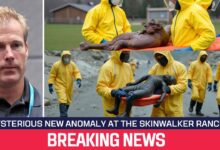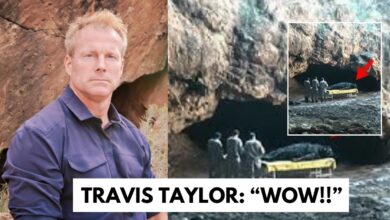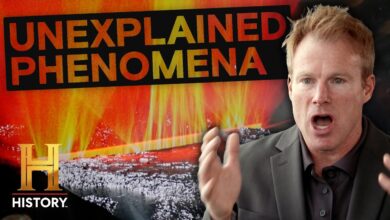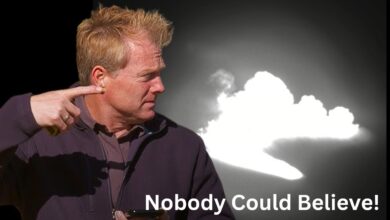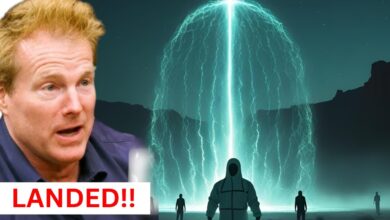
The desert has always been a place of thresholds. To the untrained eye, Anza Borego is little more than a vast sun-scorched expanse of rock and silence. But beneath the stillness lies a history of strangeness, a pattern of lights that move against the stars, of vibrations that rumble through the sand with no seismic source, of livestock found mutilated in ways nature cannot account for.
Locals whisper of black helicopters, hidden tests, and creatures that step briefly into our world before vanishing like mirages. Scientists, meanwhile, wrestle with data spikes, lost signals, and repeating cycles that defy easy explanation. What emerges is the unsettling possibility that Anza Barego is not merely a desert, but a frontier, a place where the rules of physics thin and bend, where unseen corridors link worlds together, and where time itself may falter.
Some call it folklore, others conspiracy. Yet, for those who’ve seen the orbs gliding silently above the mesas or felt the humming in their bones, it is something far more profound: a crossroads between the known and the unknowable.
When the Secret of Skinwalker Ranch team set their sights beyond Utah, they thought they were leaving one mystery behind in search of another. But in the sunbaked wilderness of Southern California, at a place called Clark Dry Lake in the Anza Barago Desert, they found something unsettlingly familiar—phenomena that mirrored the strange activity of the ranch itself.
At first glance, Anza Barago is a desert sanctuary. Visitors come for the vast silence, the rolling arid plains, and the sudden eruption of wild flowers in spring. Yet beneath the surface beauty lies a shadow history, a landscape marked by whispered sightings, vanishing creatures, and unexplained lights in the sky.
Locals speak in hushed tones of military secrecy—of black helicopters prowling the night, of nuclear experiments buried under decades of denial. The desert has always kept its secrets, but here the silence feels different. Heavy, watchful, alive.
Among the strangest accounts is the recurring appearance of a phenomenon locals call Goldie, a glowing golden-hued object that drifts across the sky as if alive. Sometimes it glimmers faintly in the distance. Other times it bursts into brilliance, commanding the horizon before vanishing without a trace. For generations, Goldie has been a mystery without an answer, a visitor without a name.
Now, with advanced instruments and years of experience at Skinwalker Ranch, the team had come to Anza Barago to confront the legend head-on. What they didn’t realize was that Goldie was only the beginning. This was not a single isolated story, but a recurring pattern of sightings stretching back decades.
Goldie was no campfire tale whispered by locals. It was a phenomenon with a paper trail, a stack of eyewitness reports, and enough consistency to demand real investigation. The plan was straightforward in design but ambitious in execution: begin in Burggo Springs, gathering baseline readings in the quiet valley, and then push into the rugged mountains near Anza, the zone where Goldie had most often been reported.
The team wanted more than speculation. They were after hard data—electromagnetic anomalies, thermal fluctuations, aerial imagery, and visual confirmation. Their goal was not to chase lights in the sky, but to pin them down with instruments.
Andy and Paul, veterans of anomaly research, led the way with a mixture of caution and anticipation. But this time, they weren’t alone. Two documentarians, Derek and Dave, joined the expedition, their cameras ready to capture every detail. Both men had history with the desert.
In 2021, they recorded footage of unusual craft darting through the night sky above Anza Borggo—objects that defied simple explanation. That evidence had never left their minds. And now, returning to the same region, they brought with them a sense of unfinished business. More importantly, Derek and Dave had secured a crucial contact: Dave Mason.
Known for his technical brilliance and long-standing collaborations at Skinwalker Ranch, Mason was more than just a cameraman or a witness. He was an engineer of perception, a man who could transform fleeting lights in the sky into measurable data. Mason arrived with an arsenal of advanced sensors packed into heavy cases and padded crates. His tools weren’t off the shelf—they were custom-built, modified, and in some cases one of a kind.
Among them were high-resolution FLIR cameras, forward-looking infrared systems designed to capture subtle shifts in temperature across wide swaths of terrain. But Mason’s edge came from the modified instruments he had spent years perfecting. One of his most prized tools was differential FLIR, a system that didn’t just show hot and cold, but tracked minute transient changes in thermal signature shifts so fleeting that standard thermal imaging would never register them.
In theory, if Goldie or any other anomalous object carried its own energy signature or distorted the air around it, Mason’s rig would detect it. Alongside this, he deployed spectrum analyzers for electromagnetic fields, parabolic microphones for capturing low-frequency hums, and synchronized GPS timestamping systems to lock every piece of data to an exact moment and place.
The team was no longer simply heading into the desert to look up at the night sky. They were preparing to dissect it—layer by layer, frequency by frequency—searching for the one piece of evidence that could transform Goldie from desert legend into quantifiable reality.
The heat signature was not static. It was dynamic, slowly expanding as if some invisible mechanism was generating energy beneath the surface. The anomaly spanned nearly 200 yards and pulsed in waves, the temperature rising and falling in rhythmic cycles.
Normal geology could not explain this. There were no geothermal vents, no seismic activity, and no underground power conduits in the area. Mason, cross-checking his calibrations, confirmed the differential FLIR was functioning properly. Whatever was happening on that ridge was real.
Simultaneously, the radio spectrum analyzer displayed bursts of narrowband emissions, perfectly timed with the thermal pulses. Each spike aligned with a sudden jump in the infrared readings, suggesting a direct link between the electromagnetic activity and the rising heat. The pattern resembled a controlled transmission, not random noise.
This wasn’t the signature of an ordinary satellite downlink. It behaved more like a beacon turning on and off in carefully modulated intervals. As the team documented the correlation, another problem surfaced. Drone footage from an overhead thermal pass abruptly cut out mid-flight, the live feed freezing before the drone itself went dark.
The system reported a total loss of signal, even though the drone was only a quarter mile away and well within visual line of sight. When retrieved manually, its batteries were drained to near zero—an impossibility given its recent full charge. It was as though the ridge itself was defending against observation, draining power and disrupting electronics the closer they came.
Derek noted the uncanny parallel to phenomena at Skinwalker Ranch—batteries dying without cause, signals appearing and vanishing, and localized zones of unexplained heat.
The team pressed further, using ground-based LAR scans to sweep the saddle where the signals converged. At first, the returns were consistent with natural terrain: rock, brush, loose desert sediment. But deeper passes revealed faint geometric echoes beneath the surface, like sharp-edged voids or cavities where none should exist.
These were not caves in the traditional sense. They reflected back with angles, symmetry, and alignment unnatural for erosion. The longer they scanned, the more the pattern became apparent—a grid-like structure buried just beneath the ridge, directly aligned with the origin point of the 1.6 GHz transmissions.
What began as a survey for Goldie had escalated into something much larger. The desert was not simply harboring strange lights. It was broadcasting, heating, and concealing. And at Clark Dry Lake, a forgotten NASA outpost turned state park attraction, the team found themselves staring into the possibility that a hidden system—technological or otherwise—was operating in plain sight.
The question was no longer if something strange was happening at Clark Dry Lake. It was why here.
The team shifted their focus back to the instruments. The radio spectrum analyzer continued spiking at 1.6 GHz, fluctuating in bursts that felt almost intelligent. The signal would vanish the moment they tried to lock it in, only to reappear seconds later, always from the same narrow gap in the mountains. It was as if something out there was aware of being watched and was adjusting its behavior accordingly.
Mason’s differential FLIR display grew increasingly unsettling. The warming ridgeline wasn’t behaving like any natural heat source. Geological heat vents radiate outward in predictable patterns, dissipating into cooler zones. This anomaly was concentrating. The ridge didn’t just warm—it pulsed, as though energy was rising from within the rock itself. A thermal bloom in real time.
The instruments caught it. Their eyes confirmed it. But there was still no rational cause.
Then the lights returned. Not one, not two—three. The first, a small white orb, blinked into existence low on the horizon where the desert floor dissolved into shadow. The second emerged along the same ridge, floating at a measured pace before sliding through the saddle, perfectly aligned with the source of the radio signal.
The third was the most unnerving: an orange-gold sphere that shimmered, then dimmed, then brightened again as if breathing. The team recognized it instantly. This was the same phenomenon that witnesses for decades had described as Goldie, a glowing entity that appeared in silence, defied explanation, and often preceded other anomalous events.
The silence around them thickened. Coyotes, usually restless and vocal on desert nights, had gone quiet. Even the faint hum of insects seemed to vanish, as though the entire environment had recoiled from what was unfolding. The desert had gone still, save for the low crackle of radios and the faint whine of equipment fans fighting to stay powered.
The investigators exchanged uneasy glances, though no one dared break the silence. Each of them knew the pattern. This was how it often began. First came the interference, then the lights, and then something else. Something harder to explain, something that crossed from the technological into the physical.
The night at Clark Dry Lake was stacking into a sequence none of them would forget: batteries draining without cause, a restricted-band signal pulsing exactly where anomalies had been recorded before, a ridge heating up as though it were alive, and luminous spheres, silent, watchful, and undeniably present.
Whatever this place was, it wasn’t just a desert. It was a stage. And tonight, something was performing.
A ridgeline heating in real time with no clear cause. Multiple instances of unexplained lights both on the desert floor and along the mountain ridge. Thermal signatures in the sky that defied classification—all pointed to a singular conclusion: something was active in the Anza Borego desert.
Back at the table with Travis Taylor and Eric Bard, the team examined the raw data. Mason’s differential system had captured perhaps the most striking find—two parallel moving heat signatures suspended in the sky, invisible to the naked eye and undetected by conventional FLIR.
The objects glided across the field of view with precise synchronized motion, maintaining a perfect spacing that suggested connection—moving in lockstep, like paired components of an engineered system rather than random natural phenomena. They produced no visible structure, emitted no navigation lights, generated no discernable engine noise, and could not be explained as birds, drones, or any known aircraft.
The resemblance to anomalies previously documented at Skinwalker Ranch was undeniable, where similar paired signatures had been observed in both thermal and visual ranges. For Taylor and Bard, the tandem aspect carried a deeper implication: that the phenomenon might represent coordinated craft or linked elements of a single larger system operating in silence and beyond ordinary detection methods.
As the frames were reviewed, Mason synchronized them with spectrum data collected from the restricted-band radio sweep earlier in the night. The results showed a faint but consistent correlation. Bursts of narrowband energy were detected from the very direction where the paired thermal objects moved—as if the signals and the heat were two facets of the same unseen presence.
This convergence of data—heat anomalies, electromagnetic bursts, and luminous orbs observed visually—was too exact to dismiss as chance. It suggested that whatever moved above the desert was emitting not only heat but information, a transmission of unknown purpose.
The implication was troubling. If the Anza Barago Desert was behaving like Skinwalker Ranch, then it was not merely a site of strange lights or folklore, but an active system interacting with its environment—broadcasting, shifting, and perhaps monitoring those who attempted to observe it.
The realization settled heavily over the team. They were no longer chasing legends of Goldie or random fireballs in the mountains. They had stumbled into a layered phenomenon, one that revealed itself only under the right conditions and only to those equipped with instruments sensitive enough to detect it.
The desert, like the ranch before it, was alive with patterns of activity waiting to be decoded. And this was only the first night.
The night’s events raised an unsettling possibility. Were the anomalies merely coincidental, or were they in some way responding to the team’s presence?
The sequence was difficult to ignore: a sudden power drain, a spike in restricted band signals, and the abrupt appearance of lights in the desert sky had all occurred only after equipment was deployed and data collection had begun.
The timing suggested not random interference, but interaction—as though the very act of observation had awakened something hidden in the landscape.
The evidence carried weight beyond curiosity. Electromagnetic anomalies, thermal irregularities, and visual sightings had converged in both time and place, forming a rare multi-sensor correlation. In the world of anomalous research, such layered confirmation is almost unheard of, often dismissed as coincidence or instrumentation error.
Yet here, in the stillness of the Anza Borego night, the data aligned too precisely to be brushed aside.
For those who had walked the shadowed grounds of Skinwalker Ranch, the parallels were impossible to overlook. Utah had revealed the same disturbing recipe: bursts of radio frequency energy erupting in restricted bands, aerial heat signatures invisible to ordinary cameras, spheres of light drifting along mesas and ridges, inexplicable battery drains, and devices failing under conditions they should have easily endured.
Now, hundreds of miles away in Southern California, the same patterns were unfolding with uncanny precision. The implication was profound.
Anza Barago might not be an isolated mystery, but another window area—a region where electromagnetic disturbances and unexplained aerial phenomena overlapped to create a nexus of strangeness.
It echoed the same elusive intelligence that had made Skinwalker Ranch infamous, raising the question of whether these sites were connected nodes in a larger unseen system.
The team was cautious not to make declarations, but the similarities were undeniable. The desert had begun to reveal itself as more than empty wilderness. It was a stage where hidden forces moved. A place where the boundaries between the natural and the unknown blurred.
For Taylor, Andy, Paul, and the rest of the crew, what had unfolded in the desert was only the beginning. The data gathered from Clark Dry Lake would require painstaking analysis—layer by layer, frequency by frequency—cross-referenced against decades of reported sightings in Anza Barago, and compared against the catalog of anomalies documented in Utah.
Patterns, if they existed, would only emerge through the kind of long grinding work that separates folklore from evidence.
The next phase was already taking shape. Multi-night monitoring would be essential to track recurring signatures over time. Aerial surveys using drones equipped with thermal imaging, multispectral sensors, and directional antennas would map the airspace in three dimensions. Ground penetrating radar might reveal hidden chambers, subterranean structures, or reservoirs of energy lying dormant beneath the sands.
Local testimony, often dismissed as campfire stories, would be recorded and cross-checked to build a coherent timeline of Goldie encounters stretching back decades.
The desert was no longer a blank canvas. It was alive with data, layered with secrets waiting to be peeled back.
As Taylor remarked to the crew: “The real work had only just begun.”
The Anza Borego desert, long overlooked even in UFO research circles, had abruptly moved to the forefront of anomaly science. Whether Goldie proved to be an advanced military platform, a natural atmospheric phenomenon not yet understood, or something stranger still, the team now had multiple independent lines of evidence confirming that something was active in those hills.
But the implications stretched beyond classification. For those who had followed the long uneasy trail of Skinwalker Ranch, the parallels were ominous. Opening the door to one mystery often meant opening it to others.
Once the threshold is crossed, there is no telling what might choose to step through. Some researchers whispered of forces operating at the margins of known physics, fields that bent energy, warped perception, or even manipulated time itself.
If Anza Barago truly was such a window, then the desert was more than just a backdrop. It was a participant, a conduit through which invisible systems revealed themselves in brief jarring flashes. And the team knew—even in this first chapter—that they had placed themselves squarely in its line of sight.
In the fringe science community, a provocative theory has been gaining momentum: that certain regions of the Earth function as energy nodes, natural amplifiers of electromagnetic and gravitational phenomena.
These places, sometimes referred to as space gates, are thought to serve as transit points where objects, energy, or even living entities might move between locations—or between dimensions themselves.
If Clark Dry Lake is one such node, then the sudden bursts of radio frequencies, the abrupt shifts in temperature, and the mysterious vanishing of lights might not be random anomalies at all, but symptoms of an active gate brushing against the fabric of our environment.
The idea gains a strange resonance when placed alongside the oral histories of the Kawia and Kumi people, whose legends speak of sky serpents and shadow beasts that appear without warning and dissolve back into nothingness.
Their descriptions of glowing orbs, streaking fireballs, and serpentine lights that writhe across the heavens echo almost perfectly the reports of Goldie that modern researchers have documented with cameras, sensors, and thermal equipment.
What the ancestors preserved as stories, the present-day team now records as data. Yet both seem to describe the same elusive phenomena playing out over generations.
The possibility is tantalizing—that the events unfolding in Anza Borego are not isolated mysteries of the present, but the latest chapter in a continuum that stretches back hundreds, perhaps even thousands of years.
The desert then becomes more than a passive setting. It is a stage where cycles of emergence and retreat, visibility and concealment, repeat endlessly, leaving human observers to puzzle over glimpses of a hidden system at work.
At the intersection of indigenous lore and cutting-edge instrumentation lies a truth both alluring and dangerous. If these ancient accounts and modern anomalies are indeed connected, then the investigation at Clark Dry Lake may not only reveal the mechanics of a natural energy node, it could also bridge two modes of knowledge—the wisdom carried through oral tradition and the precision of 21st century science.
And in that convergence perhaps lies the key to understanding what Goldie truly is.
The story of Anza Borego is not a series of disconnected incidents but a hidden rhythm, a desert metronome pulsing every 27 years with events that bend the boundaries of what we call reality. Each cycle leaves behind not only witnesses and scars, but also traces that suggest something vast, patient, and inhuman is at work beneath the sands.
1894 — the first accounts in weathered journals now locked in the San Diego Historical Society archives. Travelers on horseback describe serpents of burning gold twisting across the night sky above Clark Dry Lake. Their words speak of a hissing sound that grew louder as the lights descended, followed by a smell of scorched air. When locals later returned to the same spot, they found rings of fused glass in the sand, as though lightning had struck—but no storm had passed.
1921 — the vanishing herds. Ranchers spread across Burggo Valley wake to find entire herds of cattle gone, their corral empty as though the animals had evaporated. Those who investigate hear a low droning hum rolling across the desert at night, accompanied by lights that move too slowly for meteors, yet too fast for aircraft of the era. A local newspaper, The Borego Sun, publishes a front-page article about the desert thief—only for federal agents to seize the printing plates days later. Within weeks, Army survey crews arrive, fencing off large tracts of desert under the pretext of land assessments. No official explanation is ever offered.
1948 — the Black Triangle shadows. In the Cold War’s earliest years, Enza Borego becomes a stage for military maneuvers cloaked in secrecy. Locals report massive triangular silhouettes passing silently overhead, blotting out the stars. These shadows are accompanied by bursts of electromagnetic interference. Radios howl with static, compasses spin wildly, and car engines stall without warning. Seismic records from UC San Diego capture violent tremors centered not on fault lines, but directly beneath the desert floor near Clark Dry Lake. Meanwhile, ranch hands whisper of golden orbs rising from the sand itself, leaving behind circular impressions as though something heavy had pushed up from below.
1975 — the summer of hums. Campers and hikers describe a bone-shaking hum that rolls through the desert canyons, rattling tents and frying electronic devices. Witnesses compare it to standing inside a giant tuning fork, the vibration felt in their chest cavities as much as in their ears. Orbs of pale blue light rise from the ground at night, hover silently, and vanish with sudden bursts of heat that leave dry brush singed. Local weather stations in Borago Springs and Ocotillo go offline without explanation. When technicians are sent to investigate, they discover melted circuit boards fused into shapeless lumps—as though exposed to a sudden wave of microwaves. The stations are quietly rebuilt, their failures never officially explained.
2002 — voices in the static. Amateur radio operators monitoring the 1.6 GHz band pick up distorted transmissions, bursts of static punctuated by tones that sound disturbingly like voices speaking through water. Linguists later claim the cadence resembles human speech, though no language can be identified. That same winter, two hikers disappear near Fish Creek Wash. Their campsite is found abandoned, with food still cooking on a portable stove. The only evidence left behind is a blackened oval of sand beneath their tent—the grains fused into glassy fragments as if subjected to a blast of energy. Satellite logs from that week reveal intense unexplained signal traffic focused directly over Clark Dry Lake.
2021 — Goldie and the silent blackouts. When Derek and Dave report seeing the golden fireball, nicknamed Goldie, arcing across the desert sky, researchers scrambled to match their account against other anomalies. The timing lines up too perfectly. Seismic sensors record unexplained pulses beneath the desert floor. Unregistered satellites pass silently overhead, their trajectories logged by independent trackers but absent from official databases. At the same moment, several weather stations in the area shut down for nearly 36 hours, all citing maintenance, only to return with data gaps scrubbed from their archives. Goldie’s sighting feels less like an isolated event than the latest toll of a hidden clock—ringing once more to remind us that the rift is still there, still breathing, still waiting.
If this cycle holds true, the Anza Barago region may indeed be entering another active phase at this very moment.
From a scientific standpoint, the implications are profound. A repeating pattern of sightings and anomalies suggests a driver that could be mapped, measured, and perhaps even predicted. Astronomers would point to planetary alignments, solar maximums, or geomagnetic storms as potential culprits, noting how bursts of solar activity or tidal stresses on Earth’s crust could trigger localized electromagnetic disturbances.
Geophysicists, meanwhile, might look to the unique mineral composition beneath Clark Dry Lake, where quartz-rich deposits and fault lines could act as natural resonators, amplifying whatever subtle energies already coursed through the land.
But the speculative view opens doors far stranger. If the cycles are not merely geophysical, they could mark the rhythmic opening and closing of so-called space gates—windows where the boundary between realities thins. Some researchers whisper of an unseen clockwork in the cosmos, a hidden mechanism that determines when these portals are stable enough for passage. During these windows, lights flare, frequencies spike, and entities or machines slip across.
Such an idea could explain not just the UFO phenomena, but also a wider web of desert mysteries—the sudden appearance of creatures with no known origin, reports of time slips where travelers lose hours or even days, and objects materializing or vanishing in plain sight, defying all laws of physics.
If true, the Anza Barago Desert is not just a landscape, but a threshold, a frontier where natural law collides with something beyond comprehension. The repeating cycle may be less about random anomalies and more about a timetable, a cosmic schedule etched into the fabric of the Earth itself.
And if the team has truly documented the beginning of a new wave, it raises a chilling question: what exactly is preparing to step through this gate next?
The idea that invisible corridors connect distant points in our universe—or bridge our world to entirely different realities—is as intoxicating as it is unsettling. It reframes the desert from barren emptiness into a living map of cosmic passageways, a place where the fabric of space and time stretches thin, bending just enough to allow something to slip across.
What once looked like desolation becomes a crossroads, a hidden interchange of dimensions where the ordinary rules falter.
For the team of scientists and explorers, the Anza Barago investigation has shifted far beyond the study of a glowing orb hovering in the sky. The deeper they go, the clearer it becomes that they are no longer documenting mere anomalies. They are standing on the fault line between two worlds.
One is defined by the measurable, the repeatable, the comforting rigor of conventional science. The other is governed by forces that remain elusive, half-seen forces that only make themselves known through brief flashes of light, inexplicable vibrations, and distortions that tug at both instruments and the human mind.
As preparations for the next phase intensify, the stakes feel higher than ever. They are not simply tracking a UFO or cataloging another entry in the long history of unexplained phenomena. They are probing the margins of existence itself, attempting to pry open a curtain that may not wish to be disturbed.
And in a landscape like this—where the silence of the desert night is broken by hums without source, where creatures are reported to vanish mid-step, and where signals flicker on and off as though speaking in code—the boundary may be thinner, more fragile, and far more dangerous than anyone dares to imagine.

